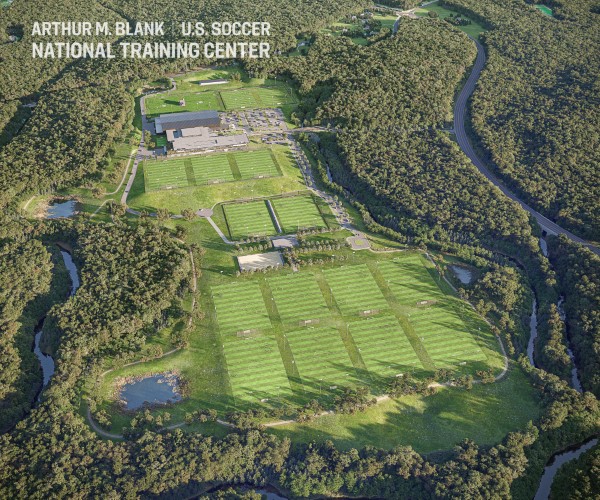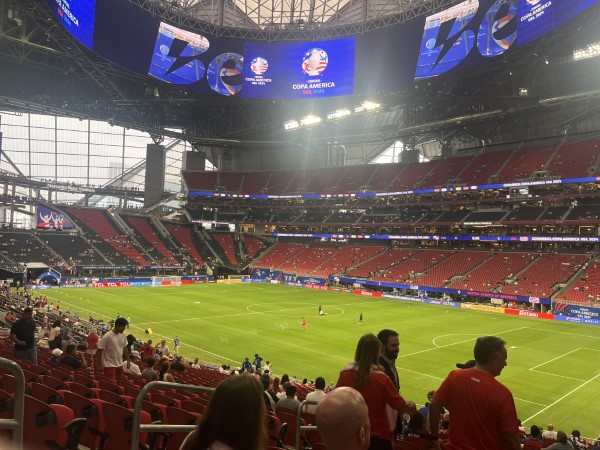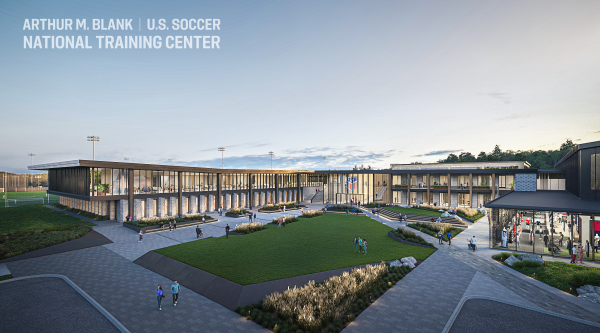Thanks to Major League Soccer’s Atlanta United, metro Atlanta has seen countless incredible goals over the past decade, from rising star Thiago Almada launching PKs into the back of the net, to prime Josef Martinez firing bicycle kicks left and right. But some of the most thrilling scores for the region’s sport fanatics will come with the multitude of major soccer events arriving in the next two years.
Soccer has grown up fast in the U.S. since the turn of the century. With two CONMEBOL Copa América matches in June, the relocation of the U.S. Soccer Federation’s headquarters and training complex to the area and eight upcoming matches (including a semifinal) during World Cup 2026, Atlanta is at the forefront of the sport’s expansion.
“Soccer is what unites all of us,” says Timo Sandritter, president and "rainmaker" at Alabama-based workforce software company RippleWorx. “It’s more than just the game itself. It’s the whole experience and the camaraderie and the debates around it that make it exciting to me.”
When contacted by phone in June, Sandritter was preparing to fly to Germany to experience the 17th edition of the UEFA European Championship firsthand. The tournament, commonly known as the Euros, calls fans from all over Europe to sing themselves hoarse in stadiums, streets and pubs. The quadrennial event brings revenue equivalent to over US$2 billion to its host country, according to SportsValue.
Sandritter sees Atlanta’s diversity as a calling card for the region when it comes to hosting similar multinational tournaments.
“Diversity in thinking, diversity in professions, and it’s a growing city," he says. With the busiest airport in the world and a vibrant downtown, Atlanta has cemented its name as a top host location for any sporting event, just as the metro region’s economic vitality has proved repeatedly why Georgia is a frontrunner for any significant corporate facility project.

“Soccer is what unites all of us.” — Timo Sandritter, President, RippleWorx, shown here with his wife at the Euro semifinal between England and Netherlands (left) and with his daughter at a recent Atlanta United game
Atlanta similarly sees diversity in the sports world, hosting a variety of tournaments and major events throughout the year across all sports, including next year’s Major League Baseball All-Star Game. Another example is the Atlanta Open, the annual tennis event taking place this week that attracts top-ranked players from all over the world.
John Isner, a prominent American tennis star who once achieved a top-10 ranking in the world for men’s singles, plays a large role in the Atlanta Open’s history as a six-time winner. At the 2024 Atlanta Open Media Day, Isner told Site Selection, “It’s not like this everywhere else in the country. So many people know about the participation numbers for both ALTA [Atlanta Lawn Tennis Association, with over 60,000 members] and the junior tennis level in the city. So for me it just makes perfect sense for this tournament to come here because you knew it was going to be supported so well.”
 Recently retired ATP tennis pro John Isner (tall guy, center) helped announce the field for this week’s Atlanta Open, just one part of Atlanta’s ever-expanding sports economy.
Recently retired ATP tennis pro John Isner (tall guy, center) helped announce the field for this week’s Atlanta Open, just one part of Atlanta’s ever-expanding sports economy.
Photo by author
However, after 15 years, this year is this particular tournament’s swan song as the ATP consolidates its global schedule and launches events in other cities. But Isner and Peter Lebedevs, executive vice president of tennis operations for GF Sports & Entertainment and tournament director for the Atlanta Open and Dallas Open, don’t think that situation will last very long. “Pro tennis belongs in Atlanta,” Isner says.
Alongside the Atlanta Open, “The A” has hosted over a dozen milestone games and events in the past 30 years, including three NFL Super Bowls, two World Series, an MLS Finals and the 1996 Olympic Games. These events have proved to be profitable endeavors for the city. But the highly anticipated relocation of the country’s soccer headquarters along with the hosting of many games in the world’s most viewed sporting event will bring a never-before-seen level of attention and related economic activity to the city.
The Peach State Becomes the Center for American Soccer
On September 15, 2023, the U.S. Soccer Federation announced its first move since 1991, planning a relocation from Chicago to Fayette County, Georgia. The USSF has acquired a property spanning over 200 acres with the help of Deloitte consultants, almost doubling the size of the training complex the federation was previously leasing in Carson, California.
After years of operations scattered across the United States, the USSF will consolidate operations at state-of-the-art facilities in Georgia. Federation officials said the location is optimal for creating a central hub for American soccer due to its short 30-minute drive from Hartsfield-Jackson Atlanta International Airport and an exceptional climate for team training throughout the year.
“Nearly all top soccer federations have a single modern national training center,” notes the USSF. “It is essential to ensure our facilities are commensurate with the teams we’re seeking to be competitive with. The new National Training Center will give our players from all 27 of our national teams uninterrupted access to elite infrastructure for training, development, rehabilitation/recovery and performance analysis.”
 The U.S. Soccer Federation’s new HQ and national training center involves a $228 million investment and the creation of nearly 440 jobs.
The U.S. Soccer Federation’s new HQ and national training center involves a $228 million investment and the creation of nearly 440 jobs.
Rendering courtesy of USSF
The USSF’s previous headquarters consisted of two adjacent mansions in Chicago and was known as “U.S. Soccer House.” The site was listed on the market at $4.2 million, and on August 11, 2023, it was purchased for residential use at a price of $3.9 million. The formerly leased training fields in California will continue to be used by the LA Galaxy, an MLS team.
The new headquarters will bring a $228 million investment to Fayette County and is projected to create almost 440 jobs. With more than a dozen soccer fields and over 100,000 sq. ft. of additional indoor practice fields, the National Training Center for U.S. Soccer can accommodate all 27 U.S. national teams and their employees. The NTC will also include over 200,000 sq. ft. dedicated to top-notch training facilities, locker rooms and office space, all in a quest to take United States soccer to the next level.
The Federation broke ground for the Arthur M. Blank U.S. Soccer National Training Center on April 8, and construction is expected to be complete in 2026, right before a potentially record-breaking event for Atlanta.
Arthur Blank, philanthropist and owner of both Atlanta United and the NFL’s Atlanta Falcons, donated $50 million to the creation of this project. Blank has worked over the past decade to help grow the soccer community within the metro Atlanta area, including bringing Atlanta United to the region in 2017. The club quickly rose to lead the league in attendance every year since its creation, becoming the first MLS team to break 800,000 attendees in a season.
The Gardener Across the Road: One Man’s Perspective on U.S. Soccer’s Big Project
Joined by Site Selection Editor in Chief Adam Bruns, I recently visited the chosen new USSF headquarters location in Fayette County, south of Hartsfield-Jackson Atlanta International Airport.
After an hour of navigating I-85 and two more local highways, we rolled into a growing region — home to the Trilith movie studio complexes, a huge new QTS data center complex and a large expansion by Piedmont Fayette Hospital, all near the “modern quaint” downtown village of Trilith. We soon arrived via a couple of forward-thinking rural roundabouts at the site, only to be greeted by “blast zone” signs and, immediately after our arrival, a huge construction truck directly behind us waiting for us to get out of the way.
Agreeing that it was in our best interest to avoid explosives and truck drivers on a schedule, we were beginning to drive away when we passed a vibrant flower garden at the entrance to a residential driveway directly across the street. The owner worked away quietly in the summer heat under the shade of his gardening hat. We decided to turn around and see if he cared to talk. He did.
Mark Green, a retired IRS spokesman and longtime Fayette County resident, shared with us the impact that he and his neighbors have felt since the start of construction approximately six months ago.
“They turned our water off in order to get water over there,” he said. “And since then, our water has been crazy with low pressure problems. So that comes with the growing pains. That’s going to happen.” As we talked, a flatbed truck carrying large water pipes rumbled up. Green waved the driver toward the construction site’s entrance.
A longtime resident of the area, Green described how drastically his surrounding environment has changed over the past year. He described how he used to watch the cattle across the way and explained the property’s legacy going back multiple generations of a different Green family in the vicinity.
“We’re the Black Greens,” he said with a laugh, which he said had led to some raised eyebrows at his property closing 34 years ago.
Asked if his family has received any sort of compensation for the impact of the project, Green said all he’d received was an offer of two tickets to attend an Atlanta United soccer game and a seismograph placed in his front yard to detect potential damages to his property from the blasts across the street.
Nevertheless, as a man of faith, he trusts the process of this change in the once peaceful semi-rural neighborhood. “We’ve been blessed, and whatever comes out of this, we know who is in control and we know that God’s going to handle whatever setbacks or adversities that may come out of this. You can’t get too stressed out or burnt out on it because it’s not going to do you any good.”
Green said he does not expect anything from the USSF as long as they continue to consider their impact on the surrounding community. He believes that each person has a social responsibility to serve the public, noting his own service of preparing taxes for free for churches and civic groups for the past 42 years.
“That’s my social responsibility,” he notes, “Will they have one? I hope they do. We hope that through the progress of their work and whatever channels they decide to go through that they keep in mind that they have a social responsibility that’s going to impact the greater good.” — David Owens
 Mark Green lives across from the site of the forthcoming U.S. Soccer headquarters and training complex.
Mark Green lives across from the site of the forthcoming U.S. Soccer headquarters and training complex.
Photo by Adam Bruns
Is Atlanta Ready for the Largest Sports Event in the World?
After Qatar’s 2022 World Cup showcased arguably the greatest finals match in soccer history, fans around the globe have been waiting on the edge of their seats for the 2026 World Cup held in North America, with Atlanta in the spotlight once again.
This will be the first World Cup tournament to include 48 nations, and Atlanta is prepared to receive an unprecedented number of soccer-loving tourists. Alongside Los Angeles, Atlanta will become the second U.S. city to host both the Olympics and the World Cup. The city is hosting eight games, including a semifinals match, in Mercedes-Benz Stadium during the summer of 2026, with each game expected to bring record viewership in the Atlanta soccer community.
Atlanta United already holds the title for highest average attendance for soccer in America at over 47,000 fans per game, and the influx of global fans is anticipated to drive match attendance up to Mercedes-Benz Stadium’s maximum capacity of 71,000 people.
An accomplishment of this magnitude was anything but easy, as government officials collaborated with delegates from companies including Delta Airlines, Chick-fil-A, the Georgia Aquarium and the Coca-Cola Company, to advertise Atlanta as the perfect candidate for such a major tournament. After years of work, the efforts of the Atlanta Sports Council proved to be fruitful. A group from the Atlanta World Cup Host Committee visited Qatar in 2022 to observe behind the scenes, learning about crucial details needed to set Atlanta up for success in 2026.
“With more than 13,000 hotel rooms in downtown Atlanta, we have the infrastructure and people in place to host world-class events and look forward to welcoming U.S. Soccer, FIFA and the fans of our great city,” says Dan Corso, president of the Atlanta Sports Council and the Atlanta World Cup Host Committee. “Atlanta offers fans, players and event operators a ‘ready to host’ city and region that is already organized across all our stakeholders.”
Major League Soccer’s Atlanta United is No. 1 in
average attendance for soccer in America at more than
47,000 fans per game.
Corso was on hand earlier this week as Major League Baseball unveiled the official logo for the 2025 All-Star Game to be hosted at Truist Park in July 2025. “With the reveal of the event logo, we are well underway in the planning process alongside our partners at the Braves,” Corso said in an MLB release. “We look forward to creating an unforgettable experience for baseball fans from around the country and the opportunity to continue to show why our region is the premier destination for hosting major global sporting events
|
|
As for the World Cup, Boston Consulting Group’s estimate shows North America generating over $5 billion in revenue, with Atlanta projected to receive roughly $415 million of that total from its eight scheduled matches. This nearly doubles the approximately $200 million of direct spending generated within the city when Atlanta hosted Super Bowl LIII in 2019, according to the Metro Atlanta Chamber of Commerce. Thousands of temporary jobs will also be created to accommodate the millions of tourists traveling to support their various national teams. During the 2018 World Cup, Russia welcomed over 5 million visitors, and local businesses received immense profits from tourism. North America is expecting a much higher count during these 39 days of soccer mania. |
Exact statistics of the economic impact are still unknown, but the CONMEBOL Copa América tournament in 2024 was an indicator of the business possibilities for Atlanta. The tournament, although smaller in fan base compared to the World Cup, drew an enormous influx of tourists to the United States. And it drew out the country’s international population. As Blue Ridge Public Radio reported last week, a huge Colombian contingent on hand for the semifinal between Colombia and Uruguay in Charlotte reflected the growing Colombian population in the Carolinas, which has reached a high enough level for the country to recently open a consulate in Charlotte.
The international diversity of Greater Atlanta also emerges when soccer is at hand. In Peachtree Corners, the same Gwinnett County suburb Site Selection calls home, U&ME Coffee Bakery Wine restaurant had a banner outside its doors displaying all the flags of Copa América teams. Inside, I talked to proprietor Pablo Vicens, a native Uruguayan who opened the establishment with his wife Paula Gil earlier this year. Most of his clientele are Americans who don’t necessarily follow soccer. But things change when a big match takes place.
“When Uruguay plays, all the time we have a party here,” Vicens said when we visited during Copa América play. “But my wife is Colombian. So when Colombia plays today, we will have a party for Colombian people too.”
That party travels. A few days before, he said, he was in Miami to watch Uruguay play Panama. Two days later, he said, he and his wife would ride a motorcycle 12 hours to see Uruguay play the U.S. in Kansas City.
 A Copa América group stage match between the United States and Panama attracted over 59,000 fans to Mercedes-Benz Stadium in Atlanta.
A Copa América group stage match between the United States and Panama attracted over 59,000 fans to Mercedes-Benz Stadium in Atlanta.
Photo by author
The U.S. previously hosted the 2016 Copa América, setting an all-time attendance record for the tournament with approximately 1.5 million fans making an appearance. A total of $190 million in revenue was also reported as a result of the tournament, and these numbers were expected to climb in 2024. Published reports indicate the U.S. Soccer Federation itself will welcome between $20 million and $25 million from hosting the event.
The magnitude of economic activity during Copa América could convince many local corporations to fast-track their pending projects in preparation for the World Cup. This year, 70,564 Atlanta locals and visitors watched Argentina beat Canada 2-0 in the Copa América opening match on June 20. Exactly one week later, Mercedes-Benz Stadium welcomed 59,145 fans as the United States endured a 2-1 loss to Panama’s national team. Both games showed promise for the level of excitement surrounding international soccer in the metro Atlanta area, and developments across downtown Atlanta are already underway in preparation for even more soccer activity in the city.
The Future is Bright
John McIntyre, professor of management and founding director of the Georgia Tech Scheller College of Business Center for International Business Education and Research (CIBER), describes the upcoming soccer momentum in Atlanta as “an incentive really to compete, raise the funds and to take the work and stick to the schedule and deliver on time.”
Considerable improvements to Atlanta’s infrastructure are unfolding. The crown jewel is Centennial Yards’ “The Gulch Redevelopment Project,” a $5 billion expansion that spans over 50 acres in the heart of the city. Partnering with architecture firm Gensler, Centennial Yards hopes to make its venue a must-see destination for local residents and tourists alike. The project will create new restaurants, office space, retail areas and a hotel, providing additional entertainment to the downtown community. A majority of the construction for Centennial Yards is expected to be completed before the 2026 World Cup.
The Metropolitan Atlanta Rapid Transit Authority’s network (MARTA) is receiving an infrastructure upgrade with considerable renovations to the Five Points Station in the city center. Backed by a $230 million investment, this project will look to improve the overall downtown transportation experience. This includes new bus bays, a remodeled transit station plaza and a large community space for the public to enjoy. The overall project is expected to be complete by 2028; however, a large portion of the renovations will be completed in time for World Cup visitors.
Concerns raised by Atlanta Mayor Andre Dickens put some service impacts and route shifts on pause early this month. But, said MARTA, “We pledge to continue working with the Mayor and other stakeholders to deliver these critical infrastructure and safety improvements, enhance the customer experience, and keep Atlanta moving forward as a world-class destination.”
The MARTA rail system has provided sports fans with a reliable transportation system directly to downtown stadiums since its inception in 1979. That said, ridership on the trains can quickly exceed capacity before and after sporting events, leading to extended periods of inefficient travel within the downtown area. This new development will evolve MARTA into a more reliable and productive network in light of the impending soccer tournaments, and the upgrades are expected to have a positive long-term impact on metro Atlanta transportation.
Whether you are a dedicated soccer fan or not, Atlanta’s success in the sports hosting business is undeniable. The soccer events’ global media exposure displaying the many attractions the region has to offer could cause a ripple effect for business in the area, furthering the region’s growth in all sectors of business.
“Atlanta knows what they’re doing when it comes to big-time events, obviously hosting the Olympics, the Super Bowl and the NCAA football national championship,” says tennis star and University of Georgia graduate Isner, who has personally participated in multinational events such as the 2012 Olympic Games. “They’re going to do a great job with the World Cup. They have all of the infrastructure that you could possibly want.” U.S. Soccer’s forthcoming headquarters and national training center aims to bring all the nation’s teams to the next level just as it will help the area’s economy do the same.
U.S. Soccer’s forthcoming headquarters and national training center aims to bring all the nation’s teams to the next level just as it will help the area’s economy do the same.
Rendering courtesy of USSF

